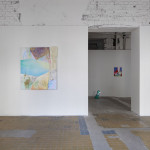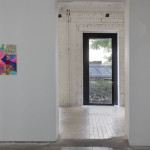SUGAR CHOICE
The choice never can be sweet. It glitters like sugar, but it is a whip. With every decision we are losing something… Finally, there is always a possibility that we are the creators of our life and we will consider it happy.
The general concept of choice is so abstract that it almost becomes incomprehensible. We are always forced to choose, continually finding ourselves at the crossroads. SUGAR CHOICE: When is the choice sweet? It’s as if you were brought into a toy store and told to pick up whatever you want … But where does the desire come from? In the case of children, it is possible to observe the conditions of their choices in relation to adopted patterns. Do adults differ from children in this process? Regardless, all our choices are recorded into our lives; they give the appearance to its being. We are not just what we are, but we are all the possibilities presented to us. Plunged into the world, we choose a way. We pass several turns in the road, bypassing infinite places where our life could have occurred. These places, these possibilities of our being, we leave forever behind us. Being is temporal and finite; the choice is irrevocable. According to Heidegger there is authentic choice, which answers our vocation and lets us be what we would like to be, and non-authentic choice, dependent upon the opinion and dictate of others.
Choice, however, is also subject to the requirement of morality. The categorical imperative commands us to act so that our actions become a general law. Space for the choice opens up between phenomena and things about themselves. If we knew things as they are and did not live only in their appearance, then there would not be any possibility to choose. We would always know which alternatives are the best, we move as “puppets in the theatre.”
However, what if it is different. We think that we choose, but we mechanically process impersonal structures. Choices are often forced by circumstances. An actor´s negotiation is determined; the body is the sum of all unaware causes. What if there is no Cartesian ego cogito, no liberal entity, only an interchangeable factor? As a consequence, there would be no choice at all; everything would be given on the basis of the position in social relations: place of birth, language, and environment. Many suggest that our blind thinking or unconsciousness follows discursive rules, and our testimony is governed by impersonal grammar. Others are convinced that we live through epidemics of memes.
We may be controlled by biological instincts and libido on a different level. Freud aptly said that we were not masters in our houses. Often we choose under the influence of the unconsciousness. Id, ego and superego struggle inside of us. We wonder whether our choices would have been approved by our father, whether the rejection of pleasures do not prevent us from living through important experience, whether the decision in favour of our ego does not make us an isolated individual without friends. We displace, sublimate, and condense without being aware of that fact. The unconscious is a black box. We ultimately do not know the final reasons for our choices. We often choose emotionally: like or dislike – however, our choices seem to be intentional, deliberate, selective and rational. More often, however, we let ourselves drift along like phantoms, acquiring half-conscious ideas unconsciously.
Does a subject exist at all, and if so, what is it? On one side there is a liberal image of a free subject that pragmatically follows aims and makes choices liberally, and on the other, there is a subject determined, defined by the outer part: „People do not think myths, the myths think inside of people“ (Lévi-Strauss)… „That we think something, it does not mean that it is our opinion “ (Ouředník).
How is it in fact, and what does it actually mean to choose? When do we choose? Is a choice at last only an illusion of choice? The choice is necessary and must be made in the urgency of the situation. Volens nolens! Avoiding choice or selection is self-destructive. Burian’s famous donkey could not choose from which haystack he should eat first, finally he died of hunger. Is it really a choice or a false semblance of choice? We do not just decide about trivialities whereas the fundamental coordinates of life are identified with us forever. Is freedom an illusion? Even if it is, our deepest desires rest upon it.
Abstract concept of choice can be explained in a language only by other abstract concepts. Abstract painting to some extent corresponds to the conceptual abstraction. The choice is not fortuitous. It extracts known forms; it takes them from the known world towards its own level of appearance, taking from it an expressive character. Concepts change into symbols and then into the more subtle levels of perception. Objectivity falls silent. Large canvases draw us into their space.
In the case of these diptych and triptych paintings, the adjacent sides of the paintings fit together kaleidoscopically and create a whole new image, special for its altered asymmetrical symmetry: Quadro-quasi-symmetry. Variable painting can be freely adjusted as a consequence, creating different environments according to the configuration. The consistency of these arrangements suggests the sophisticated work of an abstract machine of painting. “Unknown adventures in unknown space” – develops here an effect of multi-forms. We enter the space of a painting, but not in its illusory depth, but into the space in front of the image, where the colours are mirrored in the air.
An important way of understanding these paintings and artefacts is through refraction. A ray of light on the crystal cleaves its undifferentiated mixture on each colour of the spectrum. Rainbows are a spectre of light. Spectrum trumps the colour of any surface on which it falls, and it reflects their colour range. The rainbow colours are not images from the object, but they materialize in the air. Similarly, the colour is not on the surface of image, but in the reflection of light from the surface; it flutters in the air in front of it. It’s aura displayed in colours and surfaces, working with end-medium light. Sequins imbue the work with glittering reflections, allowing the dimension to shift slightly back from the surface of the image. After the eye adjusts to the brightness, the geometric-abstract field opens up in front of it. Soon the indecisiveness of the area and depth empowers the viewer. Then he finds himself in front of the problem of a visual choice. Composition is a provocation on the level of spatial perception. Abstract machines produce their own colourful mythology, in which the struggle of the human and geometric takes place.
Refraction is the quarry of the world. A seemingly invisible general fact is refracted by a crystal of a painting, which dispels the whole life into individual components. Just as the light refracts on the crystal, and the world as a mixed invisible substance breaks down into individual colours, as well as the world, referring to the individual parts of the spectrum, to their own ghosts. Events do not lie in subjects but it materializes in the air above them. Abstract painting paradoxically specifies this intuition; it reveals the unreduced status of the subject, and the problem of the source for each choice that can be brought closer again just by an abstract intuition.
Choice is a necessity.
Choice is a curse.
Choice is freedom.
SUGAR CHOICE
Michal Tošner
SUGAR CHOICE
Pro aktuální sérii obrazů a skulptur Veroniky Drahotové se stal problém volby. Pojem volby je natolik abstraktní, že ho vnímáme v jisté neurčitosti. V jazyce jej přiblížit jen metaforicky. V praxi naopak volíme konkrétně. A pak, všechny volby se zapisují do našeho života. Nejsme pouze tím, čím jsme, ale jsme také možnostmi, které se před námi otevírají. Odbočky do míst, v nichž se mohl odehrávat náš život, necháváme navždy za sebou. V jiném ohledu je volba vystavena požadavku morálky. Kategorický imperativ velí jednat tak, aby se naše jednání mohlo stát obecným zákonem.
Ale co když je to jinak. Myslíme si, že volíme, zatímco pouze strojově procesujeme neosobní struktury. Co když je jednání aktéra determinované a subjekt je jen sumou všech neuvědomovaných příčin. Mnohé nasvědčuje tomu, že naše myšlení a výpovědi slepě a nevědomě následují nevědomá pravidla, podobně, jako se naše promluvy řídí gramatikou jazyka. Možná nás na jiné rovině řídí biologické instinkty a libida. Nejsme pány ve svém domě. Často volíme pod vlivem nevědomí. Sváří se v nás id, ego a superego. Neznáme konečné důvody své volby. Necháváme se unášet fantazmaty, tj. představami, které jsme si nevědomě osvojili.
Jak to tedy je? Co znamená volit? Volba je nezbytná a musí být provedena v naléhavosti situace. Volens nolens! Vyhýbání se volbě je sebezničující. Slavný Buridanův osel se nemohl rozhodnout, ze které kupky sena má jíst dříve, až nakonec pošel hlady. Je volba jen falešným zdáním volby? – I kdyby, stejně ji potřebujeme.
Drahotová se k problému volby přibližuje prostřednictvím vizuální tvorby. Obrazné vyjádření do jisté míry koreluje s pojmovou abstrakcí. Abstrahuje známé formy, vyvazuje je z žitého světa směrem k vlastní rovině výrazu. Pojmy se mnění v symboly a ty pak přecházejí do subtilnějších rovin vnímání. Předmětnost se odmlčuje. Vstupujeme do prostoru obrazu, avšak nikoli do jeho iluzivní hloubky, nýbrž do prostoru před obrazem. Barva nespočívá na ploše obrazu, ale v odrazu světla od povrchu; chvěje se ve vzduchu před ním. Užitý materiál flitrů dává obrazům třpytivé odlesky. V jejich důsledku se pohled přesouvá mírně zpět od plochy obrazu. Po té, co si oko přivykne jasu, se mu otevírá geometricko-abstraktní pole. Záhy se divák bezděčně ocitá před problémem vizuální volby a nerozhodnutelnosti plochy a hloubky. Kompozice je provokací na rovině prostorového vnímání.
Abstraktní stroj produkuje vlastní mytologii, v níž se odehrává boj lidského a geometrického. Zdánlivě neutrální obecná skutečnost je lomena prostorem malby. Tak jako se světlo lomí na krystalu, tak se svět jako smíšená neviditelná substance lomí na své odstíny, odkazuje k jednotlivým částem spektra, k vlastním přízrakům (spectres). Výsledný dojem nasvědčuje, že dění nespočívá v předmětech, nýbrž se zhmotňuje ve vzduchu nad a mezi nimi. Abstraktní obraz paradoxně konkretizuje tuto intuici. Vyjadřuje neredukovatelný status subjektu, předmětnosti a problém pramene každé volby. SUGAR CHOICE – Volba nikdy nemůže být sladká. Třpytí se jako cukr, ale je to bič. S každým rozhodnutím o něco přicházíme… Nakonec je tu vždy možnost, že jsme tvůrci vlastního života a budeme ho považovat za šťastný. Volba je svoboda – Volba je nutnost – Volba je prokletí.





























